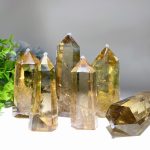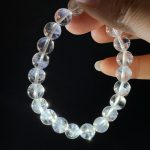Introduction
Moonstone, a mesmerizing gemstone adorned with shimmering adularescence, captivates with its moon-like glow and ethereal beauty. Beyond its enchanting appearance, moonstone possesses a unique set of physical properties, including an intriguing hardness value that plays a crucial role in its durability and versatility. This article delves into the moonstone hardness scale, exploring its significance, implications, and innovative applications for this captivating gemstone.

What is the Moonstone Hardness Scale?
The Mohs scale, developed by Friedrich Mohs in 1822, provides a standardized measure for quantifying the hardness of minerals. This scale assigns each mineral a hardness value ranging from 1 to 10, where 1 represents the softest mineral (talc) and 10 represents the hardest (diamond). Moonstone falls between a hardness value of 6 to 6.5 on the Mohs scale, indicating that it is a moderately hard gemstone.
Significance of Hardness in Moonstone
The hardness of a gemstone plays a vital role in determining its durability, scratch resistance, and suitability for various applications.
Durability: Moonstone’s moderate hardness makes it relatively durable and able to withstand everyday wear and tear. It is not as susceptible to scratching or chipping as softer gemstones, such as opal or turquoise. However, due to its slightly lower hardness, moonstone is not recommended for use in jewelry that will experience extreme impact or heavy use.
Scratch Resistance: The Mohs scale provides valuable insight into the scratch resistance of moonstone. Gemstones with a higher hardness are less likely to be scratched by everyday objects, such as keys or metal jewelry. Moonstone’s hardness of 6 to 6.5 suggests that it can resist scratches from most common household items but may be scratched by harder materials, such as topaz or quartz.
Applications: The hardness of moonstone influences its suitability for various applications. Due to its moderate hardness and durability, moonstone is commonly used in jewelry, such as rings, necklaces, and earrings. It is also suitable for use in decorative objects, carvings, and cabochons.
Strategies for Preserving Moonstone’s Hardness and Durability
To maintain moonstone’s hardness and durability, certain strategies can be implemented:
Proper Storage: Store moonstone jewelry and gemstones separately from harder objects to prevent scratching. A dedicated jewelry box or pouch lined with soft fabric is ideal.
Avoid Harsh Chemicals: Avoid exposing moonstone to harsh chemicals, such as cleaning agents or bleach, which can damage or discolor the gemstone. Clean moonstone gently using warm water and a soft cloth.
Regular Inspection: Regularly inspect moonstone jewelry for any chips or cracks that may indicate damage. If any damage is observed, seek professional repair promptly.
Moonstone Hardness Scale and Innovative Applications
Beyond its traditional applications, the moonstone hardness scale has inspired innovative ideas for utilizing this gemstone in new and creative ways:
Microelectronics: Moonstone’s moderate hardness and electrical properties make it a potential candidate for use in microelectronic devices, such as sensors and switches. Its ability to withstand wear and tear and resist scratches makes it suitable for this demanding application.
Optical Coatings: Moonstone’s hardness and optical properties suggest its potential for use in advanced optical coatings. The gemstone’s ability to reflect and refract light could enhance the performance of lenses, filters, and other optical components.
Biomedical Applications: Research is exploring the use of moonstone in biomedical applications due to its compatibility with the human body and its potential to deliver therapeutic benefits. Its hardness and durability could enable moonstone to be used in medical devices and implants.
Table 1: Relative Hardness of Common Minerals on the Mohs Scale
| Mineral | Hardness |
|---|---|
| Talc | 1 |
| Gypsum | 2 |
| Calcite | 3 |
| Fluorite | 4 |
| Apatite | 5 |
| Orthoclase | 6 |
| Quartz | 7 |
| Topaz | 8 |
| Corundum | 9 |
| Diamond | 10 |
Table 2: Hardness Comparison of Moonstone and Other Gemstones
| Gemstone | Hardness (Mohs Scale) |
|---|---|
| Moonstone | 6-6.5 |
| Opal | 5-6 |
| Turquoise | 5-6 |
| Agate | 6.5-7 |
| Jadeite | 6.5-7 |
| Emerald | 7.5-8 |
| Sapphire | 9 |
| Ruby | 9 |
Table 3: Moonstone Hardness and Suitable Applications
| Hardness (Mohs Scale) | Applications |
|---|---|
| 6-6.5 | Jewelry, decorative objects, carvings, cabochons |
| 6-7 | Microelectronics, optical coatings |
| 7-8 | Biomedical applications |
Table 4: Strategies to Preserve Moonstone Hardness and Durability
| Strategy | Description |
|---|---|
| Proper Storage | Store moonstone separately from harder objects in a dedicated jewelry box or pouch. |
| Avoid Harsh Chemicals | Clean moonstone gently with warm water and a soft cloth; avoid harsh chemicals. |
| Regular Inspection | Regularly inspect moonstone jewelry for any chips or cracks and seek professional repair promptly. |




























